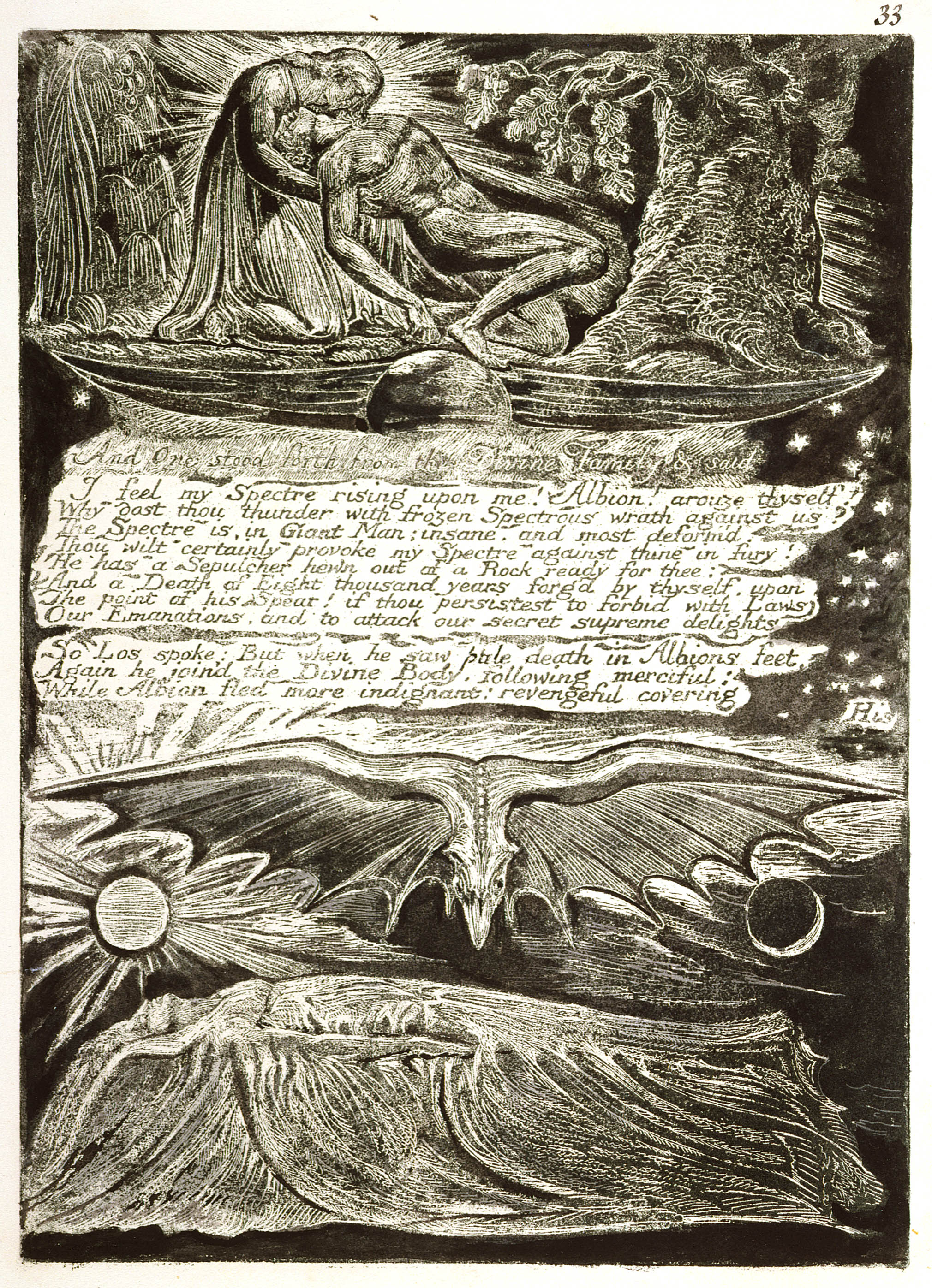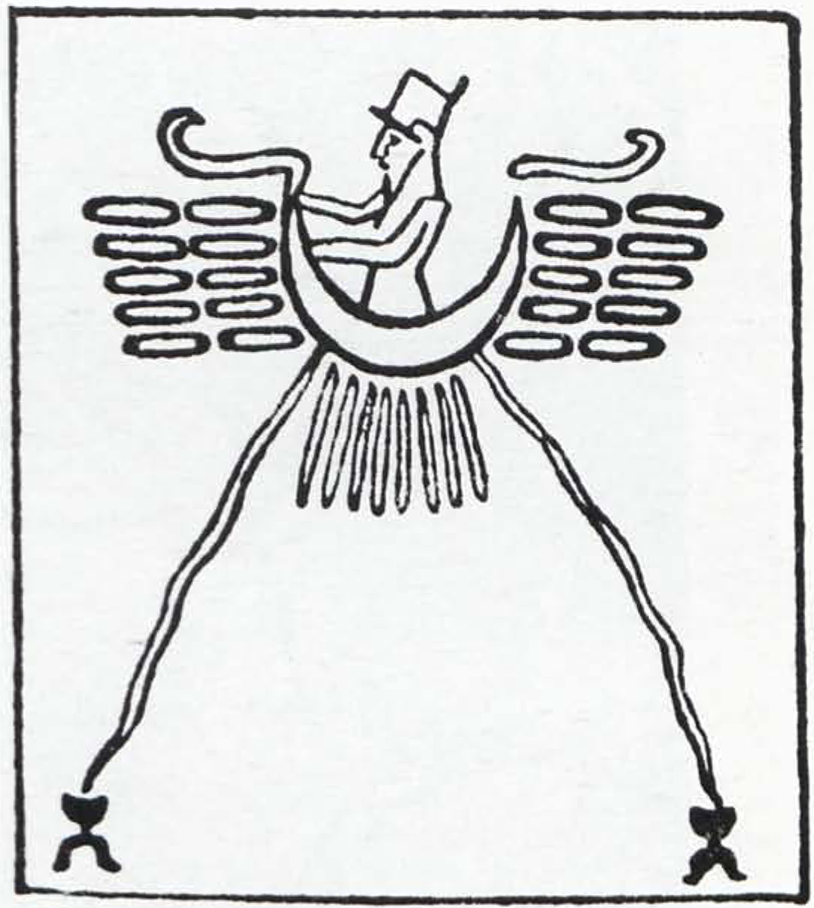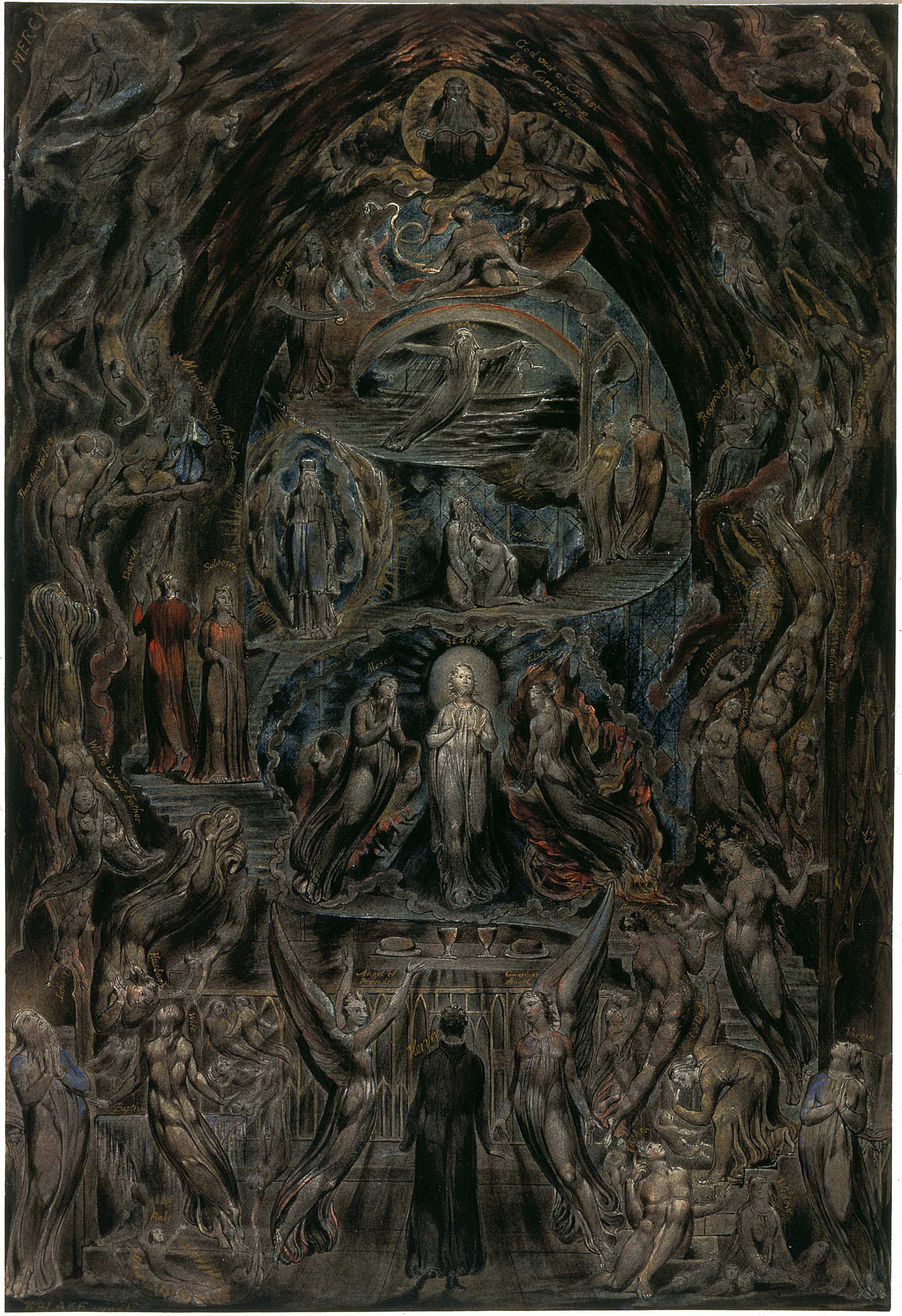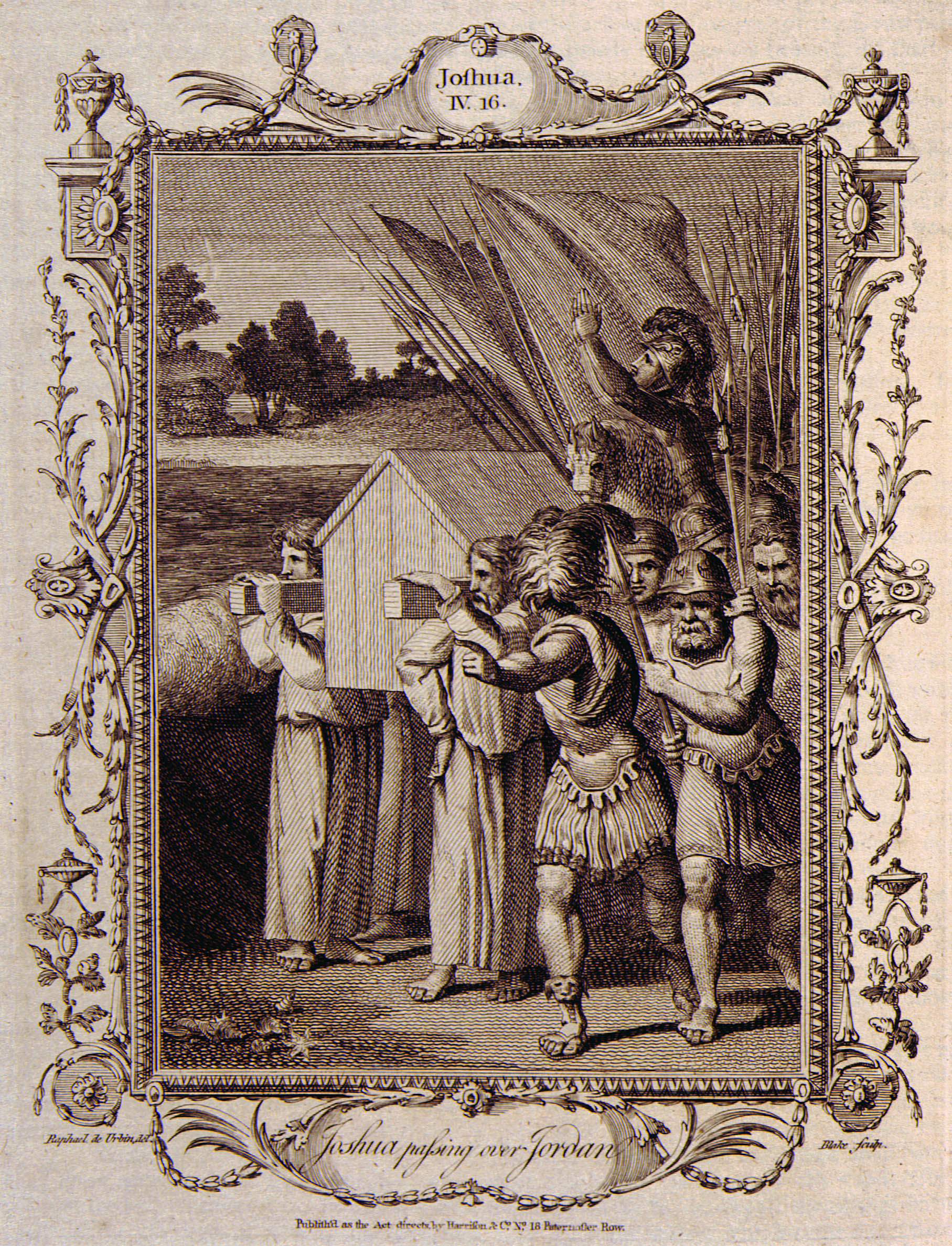article
begin page 44 | ↑ back to topBLAKE’S MOON-ARK SYMBOLISM
To a reader-viewer going through Blake’s work chronologically, the moon-ark or moon-boat probably seems a minor, perhaps even merely decorative motif. The image does not enter the Blakean canon until fairly late, 1804 and after, and then appears but sparsely—one line in Milton, four pictures in Jerusalem, a design from the Dante illustrations. Yet an examination of the moon-boat image will reveal its close connections to the basic Blakean themes of spiritual degeneration and ultimate redemption through the saving power of the imagination and of Christ’s mercy. Furthermore, Blake’s yoking of moon and boat results in an image of both spiritual illumination and spiritual transportation from one state of moral consciousness to another. Thus, if we study the moon-boat in relation to its sources in art and myth, modified by Blake into a motif compatible with his own iconography, we will discern its value as a vehicle of transition from a lower to a higher state of spiritual perception, and as a symbol of redemptive power.
So far, the only critic to discuss the subject in detail has been Albert S. Roe, who concentrates on a moon-boat from one of Blake’s designs for Dante’s Divine Comedy. I would like to begin by examining this illustration, and then go on to a more thorough analysis of the whole phenomenon of the moon-ark in Blake’s work. My procedure will be to demonstrate the symbolic values of the moon-boat as they arise from Blake’s assimilation and transformation of traditional motifs.
The moon-boat described by Roe appears in the drawing entitled “The Angelic Boat Wafting Over the Souls for Purgation,” in which an angel standing in a crescent-shaped boat bears souls away to Purgatory (illus. 1). Roe convincingly argues that this crescent boat indicates Blake’s association of this “scene with Beulah, for Beulah too is a place where spirits come and go. . . .”1↤ 1 Albert S. Roe, Blake’s Illustrations to the “Divine Comedy” (Princeton: Princeton Univ. Press, 1953), p. 140. Implicit in Roe’s analysis is the view of the moon-boat as a symbol of spiritual transit, and of Beulah as a transitional state: “Man is thus shown in this design in the in-between realm of Beulah. As the spirits embrace on the shore, the angelic boat guided by the Divine Imagination waits to take them back to the eternal joy of Eden.”2↤ 2 Roe, p. 141.
I believe that Roe’s interpretation can be elaborated and extended to the moon-ark images of Milton and Jerusalem. The sole moon-ark image in Milton occurs verbally, in Blake’s reference to Ololon, the emanation of Milton, who descends into “Felphams Vale” and the “Fires of Intellect” in the form of a “Moony Ark” (Milton 42:7-9). Ololon’s descent marks the poem’s triumphant conclusion, in which God and man, as well as Milton and his emanation, are united. But why does Blake describe Ololon as an ark, and why is the ark “Moony”? To answer this question we must first turn to Jerusalem. After examining the moon-boat illustrations from Jerusalem, we can return to the figure of Ololon with a fuller, more lucid sense of her symbolic value. However, in order to understand how Blake uses the moon-arks of Jerusalem as symbols of begin page 45 | ↑ back to top
Blake was rather miscellaneous in adapting general and specific sources for his union of boat and moon into a single image. The positive symbolism of the boat in Blake is not surprising, as the image of the ship or boat is nearly always benign both in Western and Eastern symbolism. The moon, on the other hand, often functions as a baleful symbol, a source of lunacy, an emblem of mutability and inconstancy. Yet there exist positive alternative instances of lunar symbolism, and it is on these that Blake seems to have drawn for the purposes of his own image of the moon-ark. I would like to focus briefly on three such areas of positive lunar associations—first, some general, scattered images of the moon as positive; second, a moon-boat motif possibly familiar to Blake from medieval and Renaissance Christian art; third, the moon-boat symbolism set forth by the English antiquarian, Jacob Bryant.
As an object of light, the moon often functions as a symbolic promise of the return of the sun, as in Isaiah 30:26 (“Moreover the light of the moon shall be as the light of the sun”) and Jeremiah 31:35 (“Thus saith the Lord, which giveth the sun for a light by day, and the ordinances of the moon and of the stars for a light by night”). A sign of something hopeful, bright, and definite in an amorphous sea of darkness (broken only by stars), the moon goes through its cycle of phases with reassuring regularity3↤ 3 Juan Cirlot, A Dictionary of Symbols, trans. Jack Sage (N. Y.: Philosophical Library, 1962), p. 206. (hence its many cross-cultural associations with rebirth.)4↤ 4 M. Esther Harding, Woman’s Mysteries Ancient and Modern (N. Y.: Colophon Books, 1971), p. 109. As for the ship or boat, its positive meanings, as I mentioned earlier, are numerous and wide-ranging. The ship is often depicted as an image of sanctuary, as well as of rebirth and immortality.5↤ 5 Cirlot, p. 281. A frequent symbol of refuge from a hostile sea, the ship also appears as a means of transcending mundane existence by transporting the soul to other worlds.6↤ 6 Cirlot, pp. 281-82.
Perhaps some of these associations lie behind a motif in Christian art that strikingly anticipates
Blake’s own use of the moon-boat, namely the appearance in medieval and early Renaissance art of distinctly crescent-shaped ships and boats. Now, whether there is any intended significance underlying the resemblance of boat to moon in certain works of art has not, as far as I know, received any scholarly attention. However, it is likely that an active imagination like Blake’s, prone to complex symbolic associations, might very well have made something significant of such a resemblance. Both the moon and the boat were accepted emblems of the Church in Christian iconography,7↤ 7 George Ferguson, Signs and Symbols in Christian Art (N. Y.: Oxford Univ. Press, 1973), pp. 180-81. and perhaps it is this link that such works express, or that itself appealed to Blake. One frequent symbol of the Church, Noah’s Ark, was occasionally portrayed in crescent-like form, as in a medieval manuscript of uncertain date in which the ark consists of a house set in an exaggerated crescent-shaped boat (illus. 7). This picture even brings to mind some lines about Los who, practical visionary that he is, provides Ulro with a moon to replace the lost moon of Beulah: “And Sixty Winters Los raged in the Divisions of Reuben: / Building the Moon of Ulro, plank by plank, & rib by rib” (J 32:3-4).Similarly shaped boats abound in the well-known Stuttgart Psalter, though it is doubtful that Blake would have seen it. One motif from the Psalter, however, a crescent-shaped boat in a monster-infested sea (illus. 8) is particularly interesting. The same motif occurs several times in illustrations to the Geneva, or so-called “Breeches” or Queen Elizabeth Bible, an English Bible of which there were numerous editions and copies that Blake may well have seen.8↤ 8 Between its first edition in 1560 and its last in 1616, the Geneva Bible was the most popular Bible in English, especially among the kinds of Protestant sects with which Blake felt sympathy. Even after 1616, many illustrated Geneva Bibles were available in England, and this version continued into the eighteenth century to be more widely circulated among many Protestants than the official King James Version. For useful information on the Geneva Bible, see Hugh Pope, O. P., English Versions of the Bible (Birghamton and N. Y.: Vail-Ballou Press, Inc., 1952) and T. H. Darlow and H. F. Moule, Historical Catalogue of the Printed Editions of Holy Scripture, Vol. I (London: Bible House, 1903). The significance, for Blake, of a begin page 47 | ↑ back to top
begin page 48 | ↑ back to top crescent boat as a refuge from monstrous creatures will become obvious when we realize how his own moon-arks, especially those of plates 24 and 39 of Jerusalem, symbolize refuge from the spiritual monstrosity surrounding Albion.The presence of a moon-boat in Blake’s Dante drawings leads one to suspect the possible influence of Dante’s earlier illustrators on Blake. (We should remember, however, that in Dante there is no mention of actual moon-boats.) Flaxman immediately comes to mind, but his Dante illustrations reveal no moons at all, let alone moon-boats. In one French version of Dante, however, the Bergaigne translation of 1517-25, Dante is shown riding in a small crescent-like rowboat. And in a fourteenth-century Italian manuscript, a distinctly crescent-shaped boat appears in an illustration of the City of Dis (illus. 9).
The similarity of such illustrations as those found in the Bergaigne translation, the Stuttgart Psalter, and the Queen Elizabeth Bible to Blake’s moon-arks suggests that Blake may have been familiar with these or similar sources. Although there does not seem to be any evidence for a deliberate association of moons and boats in Western art, it seems clear that Blake probably encountered some Eastern designs in which he might have noticed a similarity between boats and the crescent moon, for Egyptian art and Sumerian hymns and pictures abound in moon-boat images.9↤ 9 Maurice Farbridge, Studies in Biblical and Semitic Symbolism (N. Y.: KTAV Publishing House, Inc., 1970), p. 92. Even so, we can only speculate on Blake’s possible interpretation and transformation of the crescent boat motif into a symbol suitable for his own work. Whether or not earlier artists consciously imitated the lunar crescent in their moon-like boats, Blake’s creatively assimilative mind could easily have drawn such a correlation from their work.
On a less esoteric level, we might note that the young Blake would probably have known
the bit of British folklore that interprets a crescent moon on its side, thus resembling a
boat, as a good omen, a sign of favorable weather.10↤ 10 John Adlard, The Sports of
Cruelty (London: Cecil & Amelia Woolf, 1972), p. 66.
But it is even more certain that Blake’s moon-ark imagery derives in part from Bryant’s
Analysis of Antient Mythology, for which Blake is said to have
engraved a tailpiece depicting Noah’s ark as a crescent moon (illus. 6).11↤ 11 Ruthven Todd, Tracks in the Snow (N. Y.: Charles
Scribner’s & Sons, 1947), pp. 47-50. From Bryant Blake would have learned of the ark’s association with
the moon, as well as of many intriguing[e], if often far-fetched interpretations of Noah’s
ark and its connections to mythical figures such as Osiris and Dionysus. According to
Bryant, the ark “was a kind of crescent, such as is exhibited by the new moon; which in
consequence of it was made a type of the Ark. Hence, in the mythology of the Ark . . .
there is continually some reference to the moon . . . the Moon and the Ark were synonymous
terms.”12↤ 12 Jacob
Bryant, Analysis of Antient Mythology (London: J. Walker, 1807), Vol.
III, p. 178. Bryant goes on
to link Noah’s ark to the
festival of Osiris, when the Egyptians “constructed by way of memorial a remarkable
machine . . . an Ark in the shape of a crescent or new moon. In this the image of Osiris
was for a time concealed.”13↤ 13 Bryant, pp. 181-83.
One of the illustrations
in Bryant’s book (again, possibly designed by Blake himself)14↤ 14 Roger R. Easson, Robert N. Essick, William
Blake: Book Illustrator (Memphis: American Blake Foundation, 1979), Vol. II, p.
2.
depicts Osiris in such a boat, a crescent-shaped canoe. As the ark of Noah and
of Osiris the moon was, says Bryant, symbolic of renewal and birth: “The Ark was certainly
looked upon as the womb of nature; and the descent from it as the birth of the world.”15↤ 15 Bryant, p. 218. Both this positive value of the Ark, and the general
association of the ark with the crescent moon discussed above, were accepted and
elaborated by Blake in Jerusalem.16↤ 16 It would seem that Bryant’s association of the Ark of Osiris with
resurrection received a curiously negative adaptation in Jerusalem 21,
where Blake says of the Daughters of Albion:
I see them die beneath the whips of the
Captains! they are taken
In solemn pomp into Chaldea across the bredths of
Europe
Six months they lie embalmed in silent death: worshipped
Carried in
Arks of Oak before the armies in the spring
Bursting their Arks they rise again
to life: they play before
The Armies: I hear their loud cymbals & their
deadly cries
(J 21:42-47)
In this perversion of
resurrection and of the Israelites’ practice of carrying the Ark of the Covenant before
them, we may find a Blakean version of victim-oppressor identification that recalls the
vicious cycles of “The Mental Traveller.” In Jerusalem 21, the
Daughters of Albion emerge from their arks only to incite their former
oppressor-worshippers to further evil. The relationship between the Daughters and the
armies receives detailed exposition in Jerusalem 68.
The first instance of moon-ark symbolism in Jerusalem occurs at plate 18, where Blake depicts two small crescent sailboats apparently gliding toward one another as parallels to the two figures flying into an embrace on this plate (illus. 2). It is difficult to assign a specific valence to these moon-boats, but we can interpret them positively if, as seems reasonable, we see them as accompanying and/or paralleling the two embracing figures, and if in turn we identify these figures as the necessary, complementary fruits of Vala’s and Jerusalem’s labors, as described in the text: “For Vala produc’d the Bodies. Jerusalem gave the Souls” (J 18:7). At the same time, these moon-boats could be images of hope, offering us light or escape from the disasters of this plate—the rejection of the innocent Jerusalem by the warlike “Sons of Albion, join’d in dark Assembly” (J 18:5), who set up the all too obliging Vala as their queen, the “Goddess Virgin-Mother” (J 18:29). The usurpation of Jerusalem’s rightful place and the disruption of cosmic harmony that begin on plate 18 continue through plate 19, where Albion fails to stagger out of his spiritual stupor, and extend into plate 20, where some miniscule moon-boats reappear as tokens of hope (illus. 3). In a plate thick with despair in both the text and scattered designs, these three crescents (one with a sail, thus recalling the boats of plate 18) are the only signs of refuge or hope. Such an interpretation of these moon-boats will be more strongly confirmed if we now examine the moon-boats they seem to prefigure—the larger, more impressive arks of Jerusalem 24 and 39. The moon-arks of these later plates embrace the meanings of those on plates 18 and 20, while also seeming to offer Albion an alternative from the Ulroic state he approaches in those plates, a refuge from the temporal-spatial sea that threatens to engulf him.
On plate 24 of Jerusalem, Blake presents a crescent moon in water as a kind of Noah’s ark, much like the one he supposedly engraved for Bryant’s Mythology. The suggestion of Noah’s ark is intensified by the presence of a small, winged, dovelike figure in the boat.17↤ 17 Copies BE of this plate depict a dove with human face, a humanized form divine that perhaps underscores the supernatural, redemptive qualities of the image. (One thinks here not only of the dove in the Biblical account of the deluge, but of the moon-ark tailpiece in Bryant, with a dove hovering over it.)
In keeping with iconographic tradition, Blake depicts the ark during a rainstorm and on a turbulent sea.18↤ 18 Louis Réau, Iconographie de l’art chretien (Paris: Presses Universitaires de France, 1956), Vol. II, no. 1, p. 109. This moon-ark, with even its partially submerged hull shining luminously through the water, clearly functions as a Noah’s-ark symbol, traditionally suggestive of hope,19↤ 19 Réau, p. 109. and as a symbol of the security and love of moon-ruled Beulah (illus. 4).
In addition to these positive associations, Blake’s moon-ark very possibly serves as an image of rebirth. Such a connection is certainly implicit in Bryant, in the same volume where he links the ark with the moon: “Osiris . . . having been confined in an ark, or coffin, and in a state of begin page 49 | ↑ back to top
death, at last quitted his prison and enjoyed a renewal of life . . . the renewal of mankind commenced from their issuing to light from the Ark.”20↤ 20 Bryant, p. 248. M. Esther Harding, who has made a study of moon myths, points out a number of other sources in which the moon symbolizes the renewal of life. Considering his interest in Eastern myths, perhaps Blake knew that “the Hindus . . . speak of the moon as carrying the souls of the dead over the waters to the sun where they live a redeemed life,” or that “the Chinese moon goddess after the flood gives birth to all living things.”21↤ 21 Harding, p. 109. These myths, like Blake’s designs, present the moon-boat as a vehicle of spiritual transition. Whatever Blake’s specific sources (apart from Bryant) may have been, it is clear that previous appearances of the moon-boat in both Western and Eastern traditions would appeal to Blake in their richness of symbolic reference and association.But what is the significance of all this symbolic richness for reader-viewers of Jerusalem? What is the moon-ark’s relation to the text of plate 24, which itself depicts the weakness, delusion and despair afflicting Albion? For one thing, the visual image of the moon-boat counters and corrects Albion’s assertions of hopelessness. The text of plate 24 concludes with one of Albion’s numerous failures at begin page 50 | ↑ back to top rejuvenation, and despite the appearance of Christ, Albion sinks back to deathly sleep: “I die! I die in thy arms tho Hope is banished from me” (J 24:60). Yet the moon-ark dominating the plate, with its suggestions of Noah’s ark, of life and hope, shows that hope is not actually banished at all, as Albion erroneously thinks. The moon-ark stands as a reminder of the very life that Albion is in danger of losing, for it can bear him away from Ulro toward Beulah and Eden itself, which Blake elsewhere calls “the land of life” (The Four Zoas, I, 21:6). As Albion himself indicates, spiritual death and annihilation are not identical—if he fails to escape from his lethargy, he will “live” an eternal death of the spirit (J 23:40). This moon-ship of Beulah, though tempest-tossed, offers Albion a shelter of love and hope that can still bear him away from the torments of Ulroic death, if only he can muster the courage to board it.
A symbol of Beulah, of its love and hope, the moon-ark also suggests itself as a boundary, for Beulah serves as a boundary between Eden and Ulro, Blake’s Heaven and Hell. (Perhaps the aspect of the moon-ark that signifies a boundary even implies some sense of a tension or balance between the positive associations of the moon-ark and the moon’s frequent negative associations with mutability. While a refuge, the state of Beulah that the moon-ark symbolizes is also characterized by a “perilous
equipoise”22↤ 22 Northrop Frye, Fearful Symmetry (Princeton: Princeton Univ. Press, 1947), p. 233. between the ascent to Eden and the fall into Ulro.) As the text of plate 24 shows, Beulah is a boundary that Ulro-bound Albion is quickly slipping past. The moon-ark reminds us that Beulah, limited as it is, is a step to Eden, a step that can lead to Albion’s redemption if he will only attempt to regain Beulah and then move on to Eden. As the moon itself has served as a token of the warming light of the sun in numerous cultures, so here the moon-boat is a reminder to Albion of Eden, the fiery, sun-ruled world of the imagination. But instead of regaining Beulah at this point, Albion continues to degenerate, as evidenced by the cosmic disruption within his own system: “The Sun fled from the Britons forehead: the Moon from his mighty loins” (J 24:10). This line constitutes a verbal prophecy of what we will see graphically presented on the following plate, 25—Albion in utter begin page 51 | ↑ back to topBlake’s repetition of the moon image of plate 24 on the plate following it serves as a bitter reminder of Albion’s unfallen state, as well as of the rich promises the moon-ark of plate 24 still held. The hopes symbolized by the moon-boat seem far away indeed when their emblem, like the sun, has metamorphosed into a mere tattoo on Albion’s leg.
Besides incorporating the positive symbolic associations of plate 24, the moon-ark of plate 39 illustrates, if somewhat obliquely, the text which accompanies it. The struggle for Albion’s spiritual awakening has been dragging on throughout the poem, and finally, “furious raging” Los exhorts Albion’s friends and brothers to stretch a “hand to save the falling Man” (J 38: 12-14). Responding to Los’s urging,
With one accord in love sublime, & as on Cherubs wings
They Albion surround with kindest violence to bear him back
Against his will thro Los’s Gate to Eden: Fourfold; loud!
Their Wings waving over the bottomless Immense: to bear
Their awful charge back to his native home: but Albion dark,
Repugnant; rolls his Wheels backward into Non-Entity
(J 39:1-6)
We can easily see the extension of the symbolism of plate 24 into plate 39, where a related yet different sort of moon-boat sails over the water. The simple crescent of plate 24 has grown into a house set in a moon-like boat, and the dove of the earlier plate has been replaced by two great wings flanking the house (illus. 5). In addition to offering a vision of hope and rebirth, the design on the upper part of plate 39 supplies a visual complement to the text. This winged moon-boat, followed and perhaps impelled by the two angelic spirits behind it (two of the friends and brothers mentioned in the text), symbolically parallels the text’s account of the attempt to bear the fallen Albion back through Los’s gate to Eden. As a refuge from the non-entity threatening Albion, this moon-boat seems to symbolize those qualities, already suggested on plate 24, that can serve as a kind of spiritual barque bearing Albion back to spiritual health.
In its very function as a conveyance between two states, the moon-ark of plate 39 can also be seen as the kind of boundary between Eden and Ulro that we recognized in the ark of plate 24. Indeed, the winged moon-boat of plate 39 seems a variant of the winged disk-boundary appearing on plate 33 of Jerusalem. The design on plate 33 reveals Albion fainting back in Christ’s arms, a scene verbally described on plates 23 and 24, when Albion declares all hope to be banished from him (illus. 11). Now, just what the winged globe of plate 33 represents is unclear. In discussing this image, W. J. T. Mitchell notes that in William Stukeley’s Abury, winged orbs are interpreted as symbols of divinity, while Mitchell himself, without specifically identifying[e] the globe in Blake, argues that it is an emblem of the “eternal support of Pity.”23↤ 23 W. J. T. Mitchell, Blake’s Composite Art (Princeton: Princeton Univ. Press, 1978), pp. 181-82. Such an interpretation of the winged orb of plate 33 would be consistent with Blake’s parallel depiction of both Christ and the disk as supporting Albion—the winged disk supports Albion’s foot, just as Christ supports him in his arms. However, it is also possible that the orb actually does represent the moon. David Erdman identifies the orb as such, maintaining that its “continents are those of the moon, not earth.”24↤ 24 David V. Erdman, The Illuminated Blake (Garden City, N. Y.: Anchor Press/Doubleday, 1974), p. 312. Furthermore, winged moons are not unknown in mythology. An ancient Assyrian motif represents the moon as winged25↤ 25 Harding, p. 47. (illus. 12); Jacob Bryant, in a section of his Mythology on the symbolic links between moon and bull, presents an illustration of a winged full moon among other lunar emblems (illus. 13). Should we interpret this winged orb as a moon, we can go on to see it as an emblem of Beulah, serving as a kind of border between Albion and the Ulroic scene at the bottom of the plate, presided over by a bat-winged creature (illus. 11).26↤ 26 The fallen world of the bottom portion of plate 33 shows the moon dominated by the bat-like creature, and demonstrates the inversion of order that typifies Ulro, as the moon has its bright side turned away from the sun. The moon in this lower section quite possibly represents a corrupted moon, the emblem of Beulah transformed, like the sun of this design, into part of a fallen, evil universe. Or perhaps we are looking at Los’s moon of Ulro, which he builds “plank by plank” to replace the moon of Beulah in the fallen world, as described on the plate preceding this illustration (J 32:4). (In Blake’s textual counterpart to this design, Jerusalem 23:24-25, Albion is described as being upon the “edge of Beulah.”) The similarity between the winged moon images of plates 33 and 39 (if indeed the disk of 33 is the moon) emphasizes the similarity of their symbolic functions. In any event, the disk of plate 33, be it moon, sun, earth, or some other orb, is equipped with wings, and hence is ready to move, if necessary. The vehicular, winged moon-boat of plate 39, like its motionless counterpart in the earlier plate, represents a boundary between Eden and Ulro at the same time that it is already moving, under the guidance of the two spirits, to convey Albion back to Eden.
It is in connection with the idea of the moon-boat as both conveyance and boundary that a suggestion in Bryant’s Mythology becomes useful. Throughout his discussion of the ark’s ancient begin page 54 | ↑ back to top symbolism, Bryant implies that the moon-ark, in addition to its other symbolic values, represents “an intermediate state between a lost world, and a world renewed.”27↤ 27 Bryant, p. 81. In terms of Blake’s own symbolism, Beulah (of which the moon is chief emblem) could be viewed as such an intermediate state, between the lost death-world of Ulro and the renewed and renewing world of Eden. Albion himself needs to be redeemed from the lost world of Ulro, of non-entity, through the intermediate stage of Beulah, before going on into Eden; and what more appropriate image for his spiritual conveyance than a moon-ark, at once a boat, source of light, emblem of Beulah, and symbol of the redemption that Albion so desperately needs.
In addition to the moon-boats we have been discussing, there is a verbal instance of what might be called a moon-boat in Jerusalem when, in a pair of obscure verses, Los announces that “The Sun shall be a scythed chariot of Britain: the Moon, a Ship / In the British Ocean” (J 56: 18-19). These lines appear in a passage marked by images of holocaust, and are difficult to interpret, for the relationship of sun and moon to the surrounding imagery is not clear. S. Foster Damon sees the moon here as a symbol of love and Beulah, representing a barque of refuge from the Sea of Time and Space.28↤ 28 S. Foster Damon, William Blake: His Philosophy and Symbols, 2nd ed. (1924; rpt. Gloucester, Mass.: Peter Smith, 1958), p. 471. Yet the imagery of sun and moon in these lines disturbs, rather than calms. What we have here, after all, is imagery of great cosmic disorder,
with sun and moon fallen to earth. The sun as a “scythed chariot” suggests destruction, and the real moon, if one may be permitted so fatuous a statement, simply does not belong in the British ocean. There is nothing in the context of these two lines to indicate a positive reading of these displaced celestial objects, and the only way to make sense of them is to fit them in with the entire litany of evils of which they are a part. In this moon image we have not a redemptive moon-ark, but a symbol of disruption similar to that of plate 25, where the sun flees from Albion’s forehead, and the moon from his “mighty loins.”Thus far we have considered Blake’s ark as the union of moon and boat. Yet there is another
begin page 55 | ↑ back to top dimension to Blake’s moon-ark symbolism that depends on an apparent link, in Blake’s mind, between the Ark of Noah and the Ark of the Covenant. The connection between the two arks will provide us with a transition from the symbolism of the moon-boats to that of Ololon, the “Moony Ark” of Milton.In his commentary on Jerusalem, Joseph Wicksteed finds several connections between Noah’s Ark and the Ark of the Covenant, suggested by one of the designs we have been discussing, plate 39 of Jerusalem. Wicksteed notes that the ark of this plate must have been “associated by Blake with the Ark of the Covenant as described in Bacon’s New Atlantis, with its attendant angels guiding it from heaven.”29↤ 29 Joseph Hartley Wicksteed, William Blake’s Jerusalem: A Commentary (London: Trianon Press, 1954), p. 178. Wicksteed goes on to note the close association between the two arks as the result of the Vulgate’s use of the word arca for both, although the Hebrew words for the two arks are quite different. A similar association is found in Bryant, who discusses the merging of the symbolism of Noah’s ark, the rainbow (God’s first covenant with man), and the Ark of the Covenant: “Upon the resting of the ark upon Mount Baris, and the appearance of the Bow in the clouds, it pleased God to make a covenant with man . . . A memorial of this was preserved in the Gentile worlds. They represented the great event under the type of an Ark . . . which they styled Barith, in allusion to the covenant. Some ages after . . . another Ark by divine appointment was framed . . . and this too was called the Ark of the Covenant.”30↤ 30 Bryant, p. 429. It is worth noting, in light of Bryant’s comments, that there seems to be a similar linking of Noah’s ark, the rainbow, and the Ark of the Covenant in Blake. Blake’s depiction of Noah’s ark in his illustration, “Epitome of Hervey’s Meditations Among the Tombs,”[e] shows the rainbow above the ark illustrated in Bryant, in that both vessels seem to be mirrored or paralleled by the rainbow arc in the sky (illus. 6 and 14). In both “Hervey’s Meditations” and the design from Bryant, it is almost as if the rainbow covenant and Noah’s ark become analogous images, both figures of God’s mercy, a significance that, as I have shown, is appropriate for the moon-arks of Jerusalem as well.
Blake himself gave us a visual rendition of the Ark of the Covenant that resembles the house-like structure of Jerusalem 39 (illus. 15). Here, in this engraving for the Protestant’s Family Bible,31↤ 31 Easson and Essick, p. 28. Blake has shown Joshua safely crossing Jordan through the miraculous powers of the Ark. Blake would not fail to note that both Biblical arks had provided salvation from water, both were signs of God’s mercy, both were places of refuge (in Noah’s case, for living beings, in the case of the Ark of the Covenant, for sacred objects). Moreover, the winged house-boat of Jerusalem 39 can reasonably be said to recall the Biblical description of the Ark of the Covenant found in Exodus 37 and 38, for, as Blake himself noted, that Ark was attended by winged cherubim: “The holy spirit like a Dove is surrounded by a blue Heaven in which are the two cherubim that bowd over the Ark for here the temple is opened in Heaven.” The very next line that Blake writes links the Ark of the Covenant with that of Noah, through the image of the Dove—“the Ark of the Covenant is as a Dove of Peace.”32↤ 32 William Blake, “A Vision of the Last Judgment,” The Poetry and Prose of William Blake, ed. David V. Erdman (Garden City, N. Y.: Doubleday & Co., 1965), p. 552.
These subtle yet deep links between the two arks in Blake multiply the iconic force of the moon-ark, and extend not only its own range of symbolic reference, but that of Ololon as well. Having examined Blake’s transformative vision of traditional iconography, we can return to the image of Ololon with a fuller understanding of her identity as a “Moony Ark”—as a figure that incorporates many of the symbolic aspects of the arks we have been studying.
Both “Dove upon a stormy sea” (Milton 42:6) (we should remember here Blake’s association of the Dove of Noah with the Ark of the Covenant) and “Moony Ark,” Ololon descends to Felpham’s Vale. In so doing, she, like the moon-arks of Jerusalem, transcends the barriers between various states of consciousness and being. She contains within herself Beulah’s love, as well as the redemptive, merciful qualities that characterize Blake’s moon-ark symbols. Hence, Ololon too is a “Moony Ark,” a metaphor that becomes even more suitable because she is female, and thus, in accordance with much traditional feminine symbolism, has a mysterious link to the moon and is also a type of protective vessel. Even Christ is wrapped in a kind of sheltering mantle by Ololon—“wonderful! round his limbs / The Clouds of Ololon folded as a Garment dipped in Blood” (Milton 42:11-12). This protective, enclosing aspect of Ololon connects her to the Ark of the Covenant, which, in Catholic tradition, was interpreted as a type of the protective Virgin.33↤ 33 Charles L. Souvay, “Ark,” The Catholic Encyclopedia, ed. Charles G. Herbermann et al., Vol. I (N. Y.: Robert Appleton Co., 1907), p. 724. If, moreover, as Roe points out, Beulah is equivalent to Blake’s Purgatory, then Ololon may be his “Foederis Arca,” the Church’s traditional symbol of woman as sheltering Ark of the Covenant which enshrines the Son of God, as Ololon enwraps Christ.
begin page 56 | ↑ back to top begin page 57 | ↑ back to topIn connection with this dimension of Ololon’s symbolism, we might observe that Erich Neumann defines images of the ship, and Noah’s ark in particular, as components of the “vessel symbolism of the feminine,” and describes the many myths in which the moon functions as “the great lamp, the vessel of light of the female godhead.”34↤ 34 Erich Neumann, The Great Mother, trans. Ralph Manheim (N. Y.: Princeton Univ. Press, 1955), pp. 256-57. Ololon, as both ark and moon, clearly incorporates the powerful symbolism Neumann describes. Only when we recognize Ololon’s relation to the moon-ark and Ark of the Covenant do these added layers of her meaning become apparent.
As I indicated earlier, the reference to Ololon as a “Moony Ark” is not clear within the context of Milton alone. It would seem that Blake had already conceived of Ololon’s significance in the terms I have used, yet he did not develop the moon-ark image fully and coherently enough for his reader-viewers until he produced the series of moon-arks in Jerusalem. Looking back, then, from Jerusalem, we can perceive how abundant the phrase “Moony Ark” actually is. Furthermore, the moon-boat’s relation to the text in Jerusalem, however oblique, is nonetheless definite. A careful attention to the rapport between text and design from plate 18 through 39 of Jerusalem can expand our perception of that poem while also shedding light on the figure of Ololon. The similar rapport between Blake’s symbolism and earlier motifs can help us more fully understand his moon-ark iconography, as well as his creative assimilation of tradition.

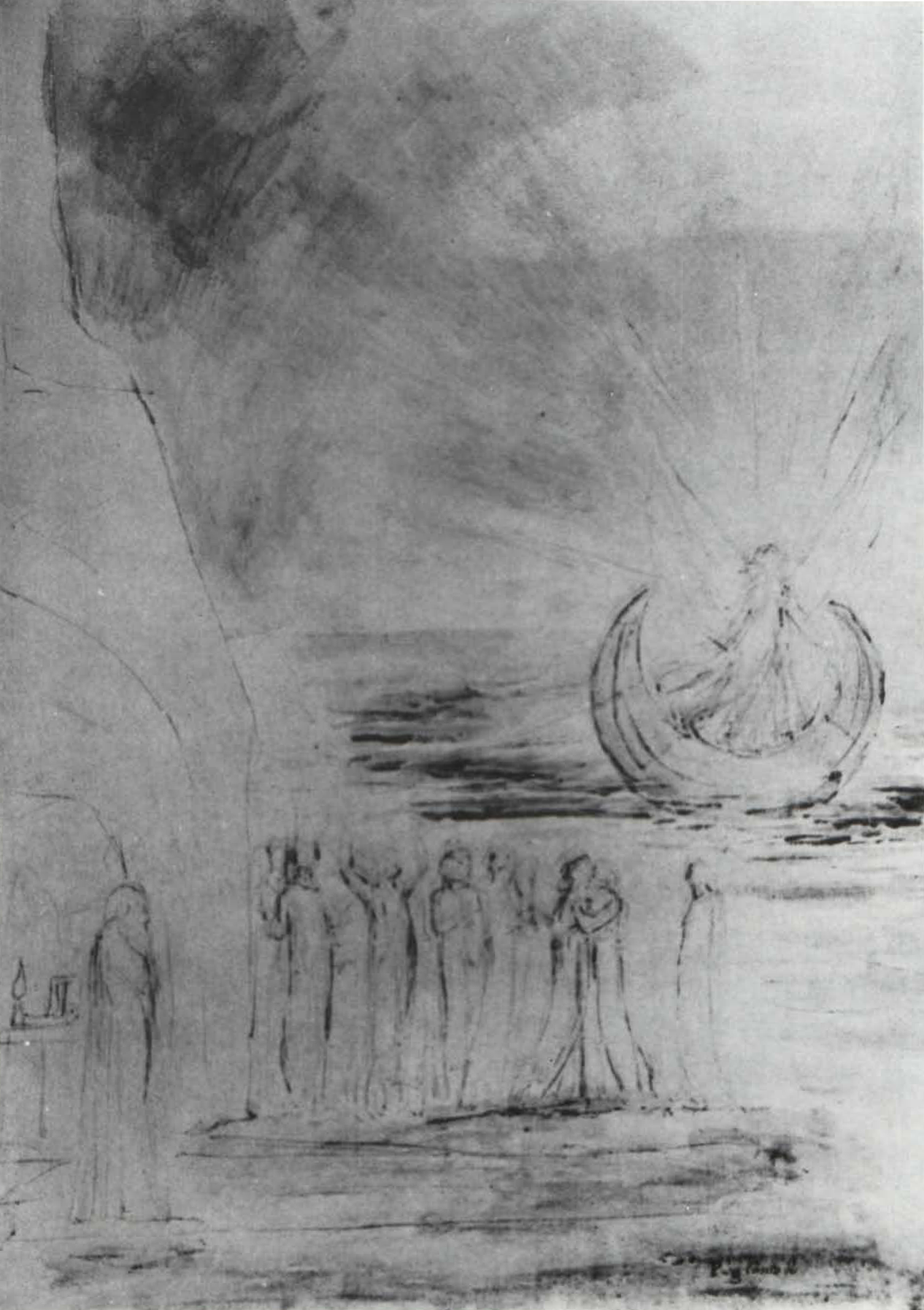


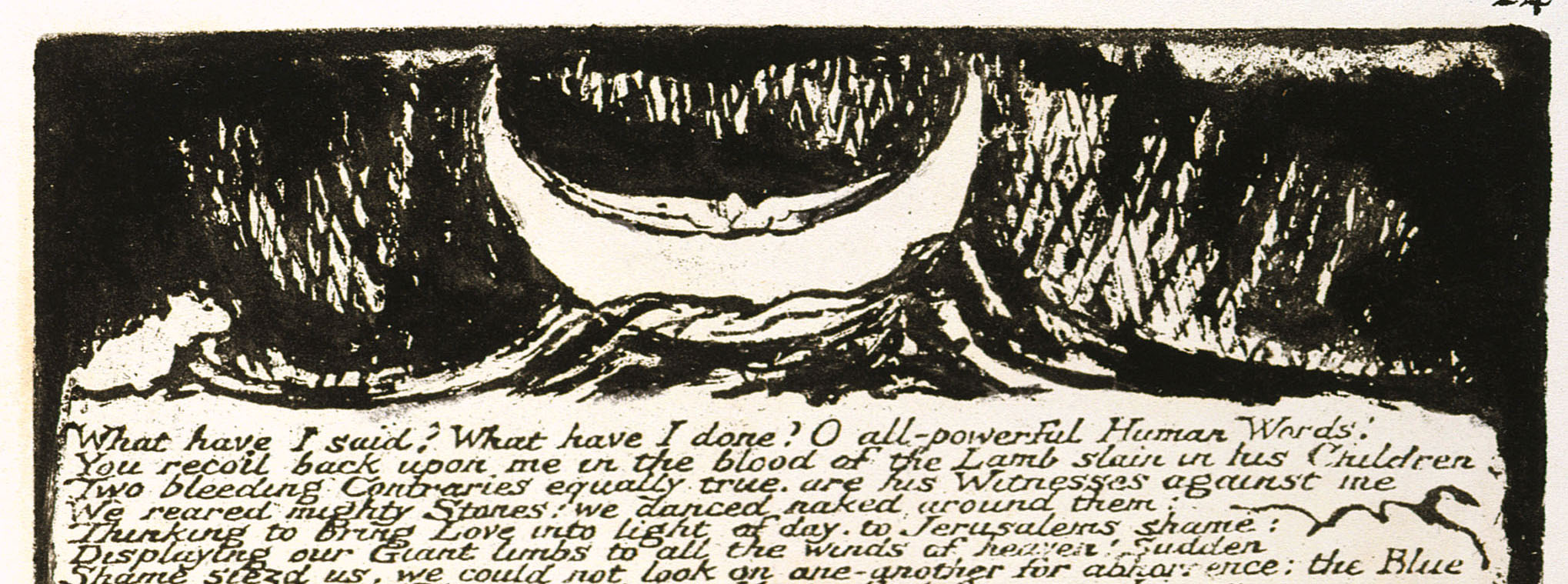
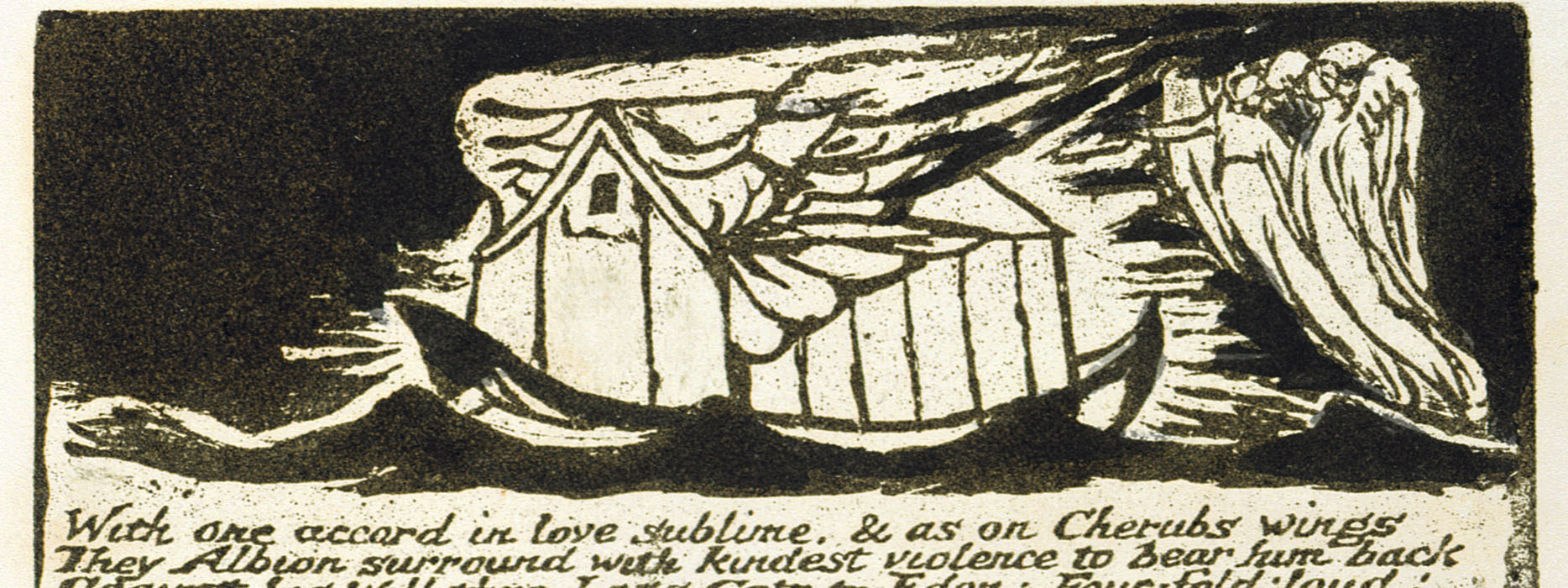
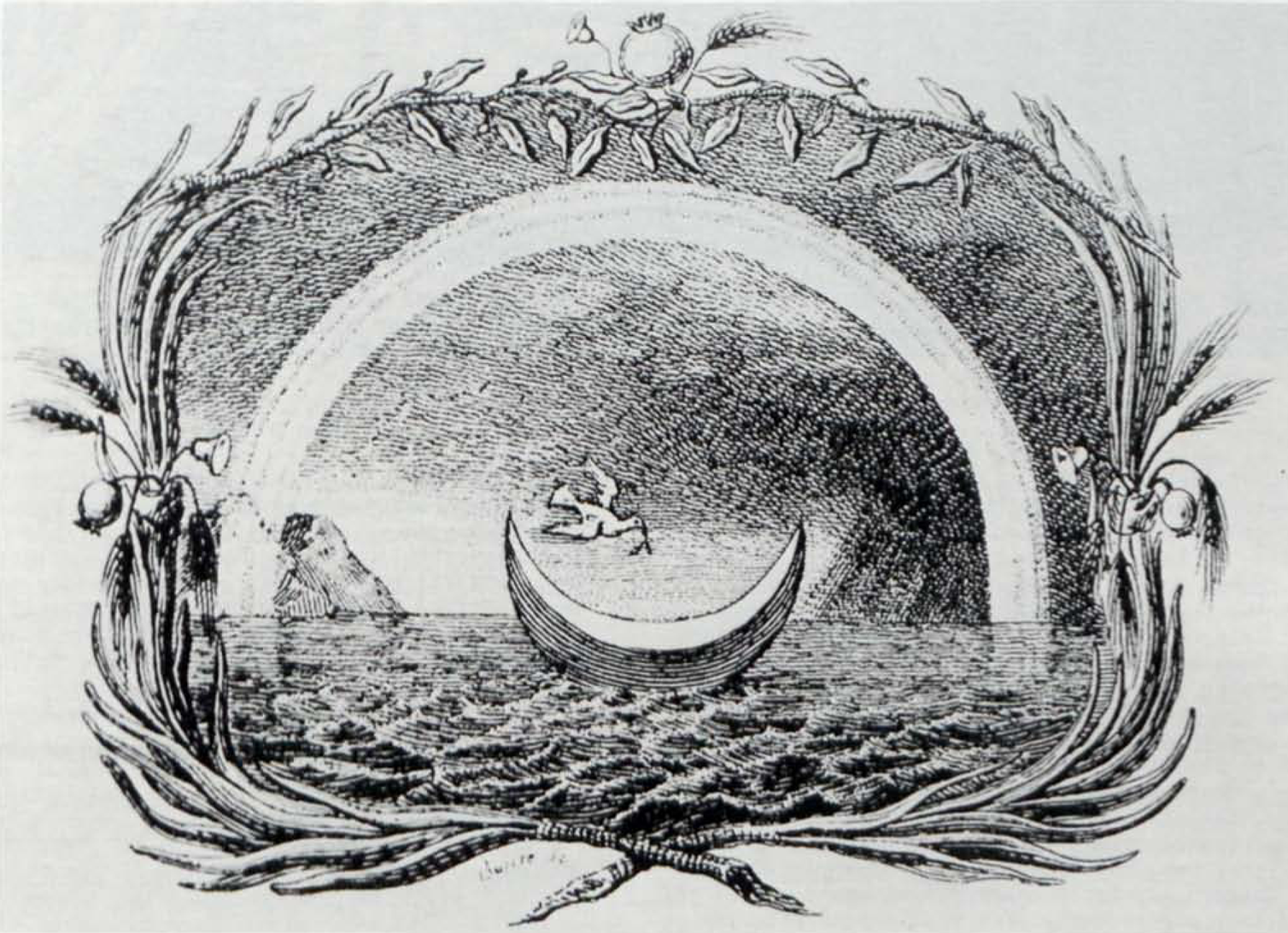
![Ici est [com]me noe est en larche o universete de totes
bestes par le [com]mandement n[ost]re seignor.](img/illustrations/AnonLeRetour.14.2.bqscan.png)
![[& laetati sunt] quia [siluerunt]
& deduxit eos in portum voluntatis eorum](img/illustrations/ChristCalmingSea.14.2.bqscan.png)
![[impor]tar chiesa sacrata. Seguita nel testo.](img/illustrations/CityOfDis.14.2.bqscan.png)

